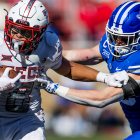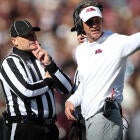Pac-12 football tiers, post-expansion: How teams from Mountain West stack up in revamped conference
Which football programs in the revamped Pac-12 are set up to thrive?

The wheels of conference realignment are spinning again with this week's news that the Pac-12 has recruited a group of reinforcements to join Oregon State and Washington State starting in 2026. Adding Boise State, Colorado State, Fresno State and San Diego State won't get the league back to its former status, but it enhances the pulse of a conference that was on life support.
While the pain of abandonment felt by Oregon State and Washington State amid the departures of 10 legacy Pac-12 members for the ACC, Big 12 and Big Ten isn't going away, at least the future is finally coming into focus. It's a future that should include the Beavers and Cougars regularly competing for league titles on the gridiron.
Washington State's last share of a Pac-12 title came in 2002, and Oregon State's last share came in 2000. But both are set to be top-tier members of the revamped conference, which will still need to make additions. Among the schools to watch could be some combination of current American Athletic Conference schools UTSA, Rice, North Texas and Memphis, according to John Talty and Dennis Dodd of CBS Sports.
So, against that backdrop, let's look at how Pac-12 football tiers could look when the revived league begins play in 2026.
Pac-12's current six schools

Oregon State
Tier I: Regular conference title contender
The skinny: Oregon State cycled through peaks and valleys in the old Pac-12, reaching double-digit victories under three different coaches (Dennis Erickson, Mike Riley and Jonathan Smith) in the 21st century. The Beavers can't wave a magic NIL wand and stock their roster with blue-chip talent on command like neighboring Oregon. But this program should be able to regularly compete for conference titles in a revamped league under new coach Trent Bray, who is a former Oregon State linebacker and tenured Beavs assistant.

Washington State
Tier I: Regular conference title contender
The skinny: Mike Leach showed Washington State's potential by leading the Cougars to five straight bowls from 2015-19, highlighted by an 11-2 mark in 2018. The Cougars have mostly been treading water since, but second-year coach Jake Dickert has them off to a strong start in 2024 entering a big Week 3 rivalry clash with Washington. Wazzu inhabited a lower tier in the old Pac-12, but it has the foundation and backing to live in the overhauled league's upper crust.

Boise State
Tier I: Regular conference title contender
The skinny: Boise State has proven itself to be the class of Group of Five football through five coaching tenures over a quarter-century. While the high-water mark came under Chris Petersen from 2006-13, the Broncos are still a perennial Mountain West contender with the resources and support to compete at the top of a revamped Pac-12. The Broncos last appeared in the AP Top 25 during the 2020 season, but they've appeared in the past two MWC title games and are the reigning league champions. First-year coach Spencer Danielson has a squad capable of competing for the Group of Five's automatic bid to the 2024 College Football Playoff.

San Diego State
Tier II: Middle of the pack
The skinny: First-year coach Sean Lewis must dig San Diego State out of a hole after it finished 4-8 last season in coach Brady Hoke's final year. But the Aztecs aren't far off after going 12-2 in 2021. If Lewis is up to the task, SDSU could be considered Tier I by the time 2026 rolls around. Rocky Long reached double-digit victories in four of his final five seasons from 2015-19, which showed that this program can be a consistent winner under the right leadership.

Fresno State
Tier II: Middle of the pack
The skinny: Offensive-minded coaches Jeff Tedford and Kalen DeBoer had Fresno State operating at a top-tier level in the Mountain West in recent years. Tedford resigned due to health issues in July, leaving the program in the hands of interim coach Tim Skipper. Navigating coaching uncertainty while gearing up to join a tougher league could be problematic. But the ingredients exist at Fresno State for Tier I-type success.

Colorado State
Tier III: Work to do
The skinny: Colorado State's last bowl appearance came in 2017, and the Rams haven't won more than seven games since the 2014 season. The program is on its third coach since then, and it remains to be seen whether third-year leader Jay Norvell will be the man who gets the program back to consistent success. The Rams won 10 or more games four times in nine seasons under Sonny Lubick between 1994 and 2002. But that's a distant memory now, and Colorado State has some catching up to do.
Potential additions

Memphis
Tier I: Regular conference title contender
The skinny: If Memphis were to leave the AAC and join the Pac-12, it would compete for conference titles because of its robust NIL situation and overall stability. Three different coaches have guided the Tigers to 10+ wins since 2014, and there have been no losing seasons since 2013. The Liberty Bowl is undergoing a significant renovation, which will modernize the Tigers' home stadium and place it on par with some Power Four venues. If four-star Class of 2025 quarterback commitment Antwann Hill can be the next in a great line of Memphis quarterbacks, the Tigers could thrive here.

UTSA
Tier II: Middle of the pack
The skinny: UTSA's ascendance under fifth-year coach Jeff Traylor makes the Roadrunners an appealing potential addition from the football perspective for the Pac-12. They finished 7-1 in the AAC last season during their first season in the league following 10 years in Conference USA. Yet another uptick in competition could prove challenging. But so long as Traylor is around, UTSA will have a high floor. The Roadrunners will have to prove they have staying power if/when Traylor moves on.

North Texas
Tier III: Work to do
The skinny: North Texas is still finding its footing in the AAC as a second-year member following 10 years in Conference USA. The Mean Green posted back-to-back nine-win seasons in 2017 and 2018 under Seth Littrell but have never reached 10 wins in 60 years at the FBS level. If a marriage between North Texas and the Pac-12 transpires, the Mean Green would face an uphill battle to success on the gridiron.

Rice
Tier III: Work to do
The skinny: As a strong academic institution with a relatively limited alumni base, Rice faces challenges in the NIL era. Seventh-year coach Mike Bloomgren has done well to get the program to consecutive bowl games. But membership in the Pac-12 would only make things more challenging. The Owls might hope to cycle up every few years to compete in the Pac-12's top half. But the down seasons would be more frequent.


















